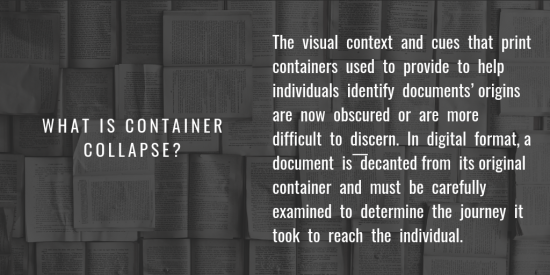Gentle reader…of late, some thoughts have weighed heavily on this librarian’s soul. I’ve always had a hard time wrapping my head around how to teach first year students how to evaluate resources.
I don’t want to feel like I’m giving heavy-handed advice and I don’t want to feel like I’m providing some binary philosophical system on
WHO TO TRUST
2016 election
I’ve become quite curious about how the 2016 election and its relationship with fake news and social media has affected how librarians teach information literacy. Read more about it in the preprint Post-Facts: Information Literacy and Authority after the 2016 Election and Why Libraries Can’t Fight Fake News.
Container collapse

Also, I’ve been slowly digesting the findings from the big longitudinal study Researching Students Information Choices (RSIC). This research has coined the term “Container Collapse” — What happens when you “decant” information from its original container (book, journal, newspaper) and turn it into a document in a database that looks like all the others? You get container collapse. Can students recognize these different types of resources? Do these different types of documents matter anymore? The research suggests that heuristics (cues to interpret) don’t help all that much and that deep engagement is needed to evaluate sources.
Many students have been taught to evaluate resources using normative heuristics like “is it a .org or a .com?” I wonder if too great of a focus on these simplistic shortcuts has led to a lesser engagement with evaluation of resources.
CRAAP not — SIFT to the rescue
The CRAAP test has long been used as a way to evaluate sources. However, it can be a bit overwhelming to some students, so they just don’t bother doing it despite its very fun scatalogical name. SIFT takes a more realistic approach and has students take a gander at the source of the document as a primary way to evaluate its worthiness. SIFT is the new CRAAP.
STOP
INVESTIGATE THE SOURCE
FIND TRUSTED COVERAGE
TRACE BACK TO THE ORIGINAL
Curious about SIFT? Learn more from this SMSU LibGuide on the SIFT Process
What do you think?
For the youngsters out there: Did the 2016 election have an effect on how you were taught to evaluate sources?
For the more “seasoned”: Did the 2016 election have an effect on your teaching of this skill? Or did it have an effect on how your librarian friends talked about it?
Gentle reader, I’d like to know.
